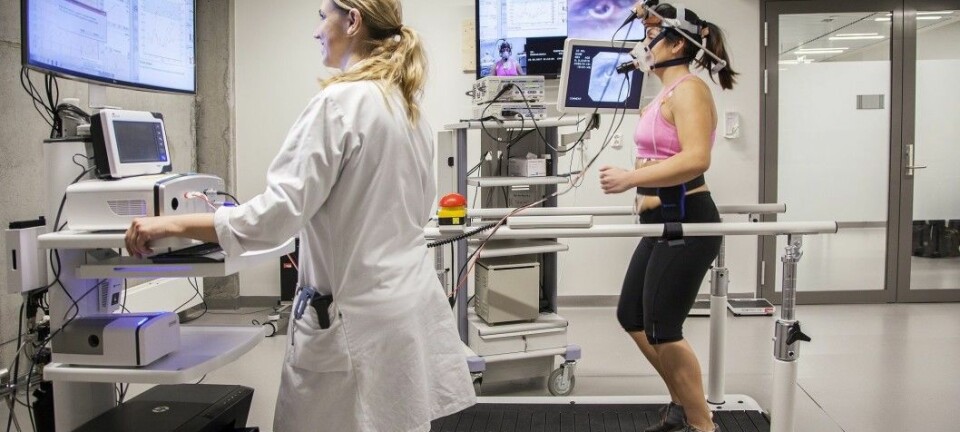
Asthma or EILO: Are misdiagnosed breathing difficulties making children and adolescents less active?
EILO is a breathing problem that can be confused with asthma. Doctor believes many people don’t know they can get help.
Doctors in Norway prescribed asthma medication for more than 80 000 children under the age of 18 in 2017, according to a report from the Norwegian Institute of Public Health.
But researchers working on a less well known breathing problem called EILO, are concerned that many of them were misdiagnosed.
EILO is the abbreviation for Exercise Induced Laryngeal Obstruction. Individuals with the condition find that their airway narrows, either completely or partially, during strenuous physical exercise. The symptoms subside quickly when exercising stops.
EILO isn’t dangerous, but many people find it frightening. While people with asthma often have difficulty when they exhale, EILO is often characterized by difficulty breathing when inhaling.

Only recently has it become possible to effectively examine people for EILO.
Hege Clemm is a senior consultant in the Children and Youth Clinic at Haukeland University Hospital. It is primarily here that people in Norway are being tested for the condition.
“A lot of people don’t know they can get help with this problem, so that they can maintain an active lifestyle. It’s important for the public to learn about EILO and that they can get help,” says Clemm.
She estimates that 80-90 percent of those who come for an exam have used asthma medications and that up to 70 percent do not need them. Asthma drugs are ineffective for EILO.
Just how big a problem EILO is in Norway is uncertain. But a so far international research has indicated between 5 and 7.5 per cent.
Now the Haukeland researchers are going to collaborate on a research project with researchers at the Norwegian Sports Academy (NIH). They will be looking more closely at physical activity and shortness of breath among young people, and examine them for both asthma and EILO.
Athletes prone to EILO
Associate Professor Trine Stensrud at NIH also believes that many more children and adolescents in Norway should be tested for EILO.
EILO is a relatively new diagnosis. But the researchers who work with top athletes have known about it for quite some time, according to Stensrud.
Athletes tend to be susceptible to both EILO and asthma.
In fact, almost 20 percent of EILO patients at Haukeland are high-level athletes, says Clemm.
But the problem of misdiagnosis isn’t greatest among the top athletes, say Clemm and Stensrud.
National team athletes have an experienced medical team overseeing them and are regularly and thoroughly examined.
“The problem is far greater for the thousands of children and young people who aren’t receiving help with EILO, because distinguishing the symptoms from asthma can be difficult,” says Stensrud.
Public knowledge still limited
Clemm has found that doctors and others who work within sports medicine are becoming quite familiar with EILO.
“The topic has been well covered at several medical sports conferences in Norway and also internationally,” she says.
But within some sports and at an international level, there’s still a lot of work to do to spread information on EILO,” says the Haukeland researcher.
Extent of problem uncertain
Too little knowledge about EILO may be a problem among healthcare personnel who take care of breathing issues for children, adolescents and adults in Norway.
Clemm believes that the problem of misdiagnosing and underdiagnosing EILO in athletics is greatest among strong athletes who train a lot but aren’t at the top level.
“Breathing problems are probably assessed slightly differently around the country. A lot of people may get an asthma diagnosis when their lung function is tested without having provocation testing done as well. What’s important then is to remember to test for problems in the larynx if asthma treatment doesn’t result in improvement,” she says.
“A lot of people have both conditions, perhaps especially among athletes, and may experience feeling a little better, but not 100 percent,” Clemm says.
Fears that children will become sedentary
Clemm and her colleagues found that children get flown in by air ambulance helicopters because they can’t breathe. They have been put on steroids, but then it turns out that they have EILO.
Some of the children who come to the clinic have been investigated multiple times already.
Clemm is concerned that many people don’t get the right diagnosis and therefore stop being physically active for fear of not being able to breathe.
“I’m also concerned about broad-based sports and physical activity in the general population. Children, adolescents, and adults who experience difficulty breathing, and who aren’t high-level athletes, are more likely to avoid activity that triggers these symptoms. It’s awfully uncomfortable to feel like you can’t breathe.
This group of patients probably won’t consult a doctor either, Clemm thinks, because they discover that they can solve their problem by not exercising.
But what is it about physical activity that triggers EILO?
Narrowing of the airways
Athletes may notice they have a breathing problem more readily than other people. One reason for this is that the demand for keeping the airway open is greater since they move huge amounts of air in and out through their windpipe when they exercise. This can lead them to seek help for it, the researchers believe.
EILO causes the airway to narrow for a little while – instead of giving free passage for the breath. Every inbreath may have a wheezing sound, like in the sound clip below.
There is still a lot that researchers do not know about EILO – for example, why some people get it and not others.
But they know that the larynx is vulnerable to the forces at work when inhaling, because it is the narrowest part along the path into the airway. That’s where a narrowing or closing of the airway occurs more easily.
Clemm says her team hopes to learn more from an ongoing study where they are examining laryngeal conditions in healthy athletes without any known breathing problems.
------------------------------
Read the Norwegian version of this article at forskning.no
































